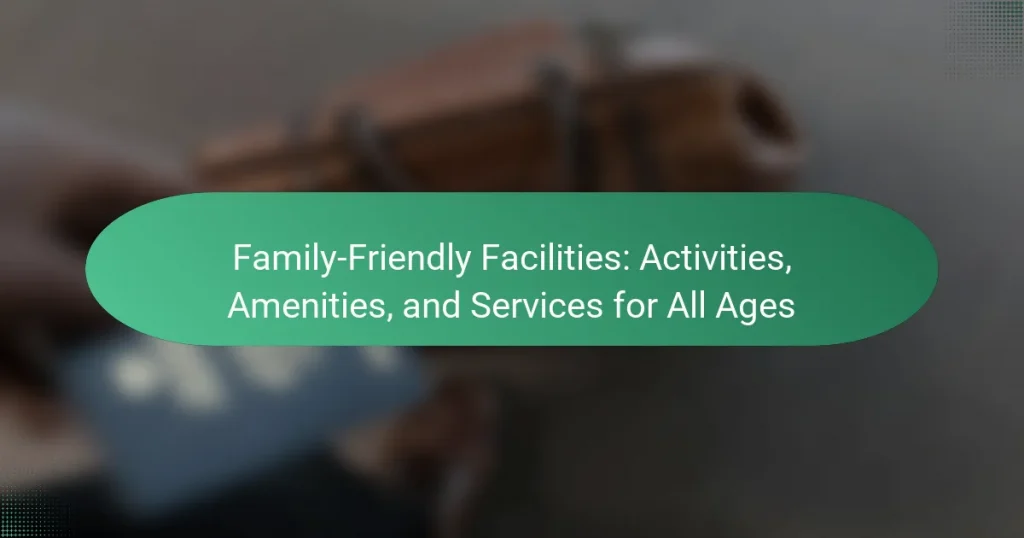Family-friendly facilities are designed to meet the needs of families and children, featuring amenities such as play areas, child-friendly dining options, and nursing rooms. These spaces foster a welcoming environment for families to engage in activities together, enhancing family bonding and social interaction. Examples of such facilities include parks, restaurants, and recreational centers specifically equipped for children’s needs. Research, including findings from the American Academy of Pediatrics, indicates that access to these facilities positively influences children’s development and overall well-being. The article will explore various activities, amenities, and services offered by family-friendly facilities, highlighting their importance for all ages.

What are Family-Friendly Facilities?
Family-friendly facilities are spaces designed to accommodate the needs of families and children. These facilities often include amenities such as play areas, child-friendly dining options, and nursing rooms. They aim to create a welcoming environment for families to enjoy activities together. Examples include parks, restaurants, and recreational centers with special features for children. Research shows that such facilities enhance family bonding and social interaction. According to a study by the American Academy of Pediatrics, access to family-friendly spaces positively impacts children’s development and well-being.
How do Family-Friendly Facilities cater to different age groups?
Family-friendly facilities cater to different age groups by providing tailored amenities and activities. For infants and toddlers, these facilities often include safe play areas and interactive toys. For preschoolers, they offer educational programs and age-appropriate games. School-age children benefit from organized sports and creative workshops. Teenagers find entertainment options like gaming zones and social spaces. Adults enjoy relaxation areas and fitness classes. Seniors may access quiet zones and wellness programs. Each age group is considered in the design and programming of these facilities to ensure inclusivity and engagement.
What specific activities are available for children in Family-Friendly Facilities?
Family-friendly facilities offer a variety of activities for children. Common activities include playgrounds with safe equipment. Many facilities provide organized sports and games. Arts and crafts stations allow for creative expression. Educational workshops often engage children in learning. Swimming pools with designated children’s areas promote water safety and fun. Storytime sessions encourage reading and imagination. Interactive exhibits in museums stimulate curiosity and exploration. These activities cater to different age groups and interests, ensuring a well-rounded experience for children.
How do Family-Friendly Facilities accommodate adults and seniors?
Family-friendly facilities accommodate adults and seniors by offering accessible amenities and activities tailored to their needs. These facilities often include ramps, elevators, and designated seating areas to ensure mobility and comfort. Additionally, they provide quiet zones for relaxation and social interaction. Many facilities feature programs specifically designed for adults and seniors, such as fitness classes and workshops. This inclusivity promotes engagement and interaction among all age groups. Research shows that such environments enhance social well-being and community involvement for older adults.
What amenities are typically found in Family-Friendly Facilities?
Family-friendly facilities typically offer amenities such as play areas, family restrooms, and child-friendly dining options. Play areas provide safe spaces for children to engage in physical activities. Family restrooms often include changing tables and ample space for parents with young children. Child-friendly dining options include menus designed for younger tastes and high chairs for convenience. Many facilities also provide supervised childcare services, allowing parents to enjoy activities while their children are cared for. Additionally, some family-friendly facilities feature educational programs or workshops tailored for kids. These amenities enhance the overall experience for families, making outings enjoyable and stress-free.
Which safety features are essential in Family-Friendly Facilities?
Essential safety features in family-friendly facilities include childproofing measures, secure play areas, and emergency procedures. Childproofing measures prevent access to hazardous areas. Secure play areas should have soft surfaces to minimize injury. Emergency procedures must be clearly posted and practiced regularly. Adequate lighting enhances visibility, reducing accidents. Trained staff can respond effectively to emergencies. Regular maintenance ensures equipment is safe and functional. These features collectively contribute to a safe environment for families.
How do dining options enhance the experience in Family-Friendly Facilities?
Dining options enhance the experience in family-friendly facilities by providing diverse and appealing meals for all ages. These dining options cater to various dietary needs, ensuring inclusivity. Families can enjoy meals together, fostering bonding time. Kid-friendly menus often include fun and healthy choices, promoting better eating habits. The ambiance of dining areas can create a welcoming atmosphere. Additionally, themed dining experiences can add excitement and engagement for children. Accessibility and convenience of dining options reduce stress for families during their visit. Overall, quality dining enhances satisfaction and encourages longer stays in family-friendly facilities.
What services do Family-Friendly Facilities offer to enhance visitor experience?
Family-friendly facilities offer a variety of services to enhance visitor experience. These services include childcare options, which allow parents to enjoy activities while their children are cared for. Many facilities provide family restrooms equipped with changing tables for convenience. They often have play areas designed for children, ensuring safe and engaging environments. Additionally, family-friendly facilities may offer educational programs and workshops tailored for all ages. Some provide dining options with kid-friendly menus. Accessibility features are typically included to accommodate families with special needs. These services collectively contribute to a more enjoyable and stress-free experience for families visiting these facilities.
How do Family-Friendly Facilities provide support for families with special needs?
Family-friendly facilities support families with special needs by offering accessible amenities and tailored services. These facilities often include wheelchair ramps, accessible restrooms, and sensory-friendly spaces. They may provide specialized staff training to better assist families. Many facilities also organize inclusive activities that cater to various abilities. Support services might include quiet areas for overstimulated individuals. Some facilities offer resources for parents, such as support groups or informational materials. These features ensure that families with special needs feel welcomed and accommodated. Research shows that inclusive environments enhance the experience for all visitors, fostering community engagement.
What entertainment options are available in Family-Friendly Facilities?
Family-friendly facilities offer a variety of entertainment options. These options include playgrounds designed for children of various age groups. Many facilities provide organized activities such as arts and crafts sessions. Some locations feature game rooms with board games and video games. Outdoor spaces often include sports courts for basketball or soccer. Movie screenings for family-friendly films are also common. Additionally, some facilities host live performances or interactive shows. These entertainment options cater to diverse interests and age ranges, ensuring enjoyable experiences for families.
How can families choose the best Family-Friendly Facility for their needs?
Families can choose the best family-friendly facility by assessing their specific needs and preferences. First, they should identify the age range of their children. Different facilities cater to various age groups with appropriate activities. Next, families should consider the types of amenities offered. Facilities with playgrounds, swimming pools, and educational programs are often more appealing.
Safety is also a crucial factor. Families should look for facilities with secure environments and qualified staff. Additionally, location and accessibility play a significant role. A facility that is easy to reach can enhance the overall experience.
Reviews and recommendations from other families can provide valuable insights. Online platforms often showcase ratings and feedback on facilities. Finally, trial visits can help families gauge the atmosphere and suitability of a facility. Engaging with staff during visits can also clarify available services.
What factors should families consider when planning a visit to Family-Friendly Facilities?
Families should consider accessibility, safety, amenities, and activities when planning a visit to family-friendly facilities. Accessibility includes transportation options and facility layout for strollers. Safety involves checking for childproof areas and emergency procedures. Amenities like restrooms, food options, and changing stations enhance comfort. Activities suitable for various age groups ensure engagement for all family members. Additionally, reviews and ratings from other families can provide insight into the facility’s quality. These factors contribute to a positive experience for families visiting such facilities.
How can families ensure a fun and safe experience at Family-Friendly Facilities?
Families can ensure a fun and safe experience at family-friendly facilities by following specific guidelines. First, they should review the facility’s safety measures, such as childproofing and emergency protocols. Facilities often have safety ratings or certifications that indicate their compliance with safety standards. Second, families should supervise children at all times, as active supervision reduces the risk of accidents. Third, they can participate in organized activities, which are typically designed for safety and engagement. Many facilities provide staff trained in first aid and child supervision. Fourth, families should familiarize themselves with the layout of the facility, including exits and emergency procedures. This knowledge enhances preparedness in case of an emergency. Lastly, families can check online reviews or testimonials to gauge the experiences of others regarding safety and enjoyment at the facility. These steps collectively contribute to a secure and enjoyable outing for families.
Family-friendly facilities are designed to meet the diverse needs of families and children, featuring amenities such as play areas, family restrooms, and child-friendly dining options. This article explores how these facilities cater to various age groups, offering tailored activities for infants, toddlers, preschoolers, school-age children, teenagers, adults, and seniors. Key aspects include safety features, entertainment options, and services that enhance the visitor experience, such as childcare and accessible amenities for families with special needs. Additionally, the article provides guidance for families on selecting the best facility based on their specific requirements and ensuring a fun and safe visit.




